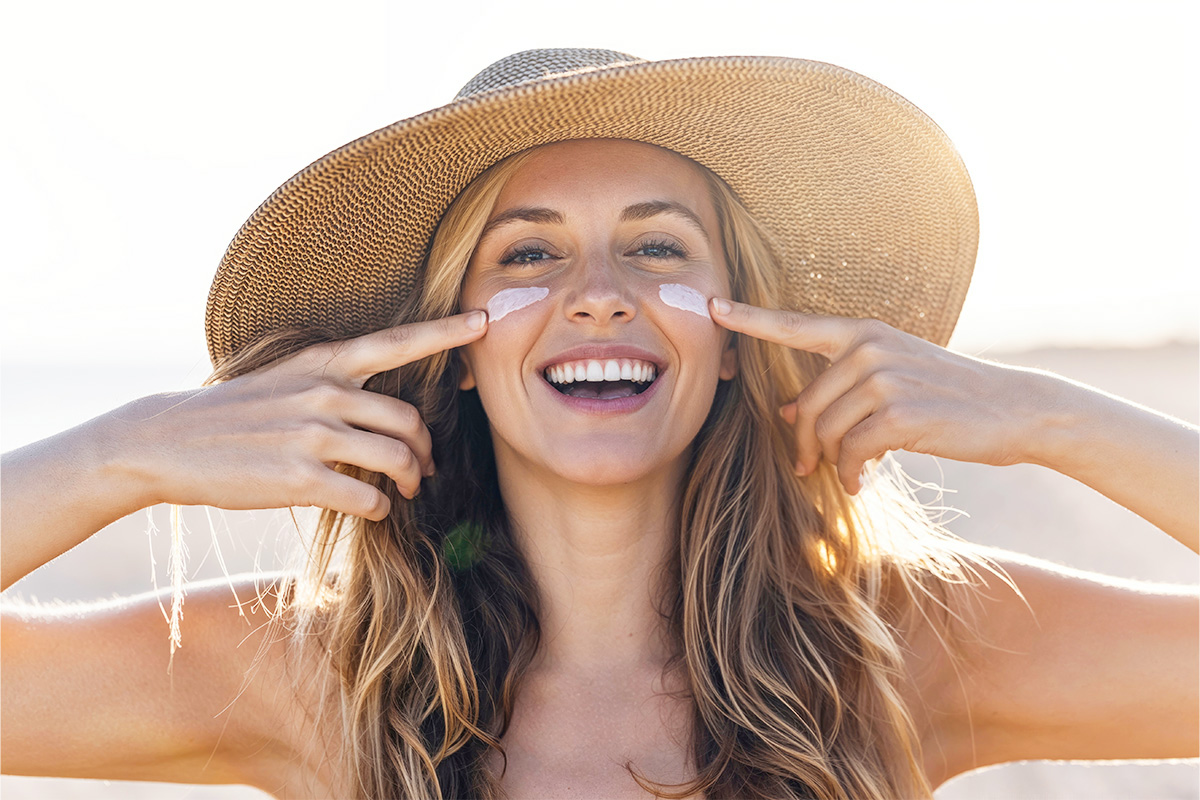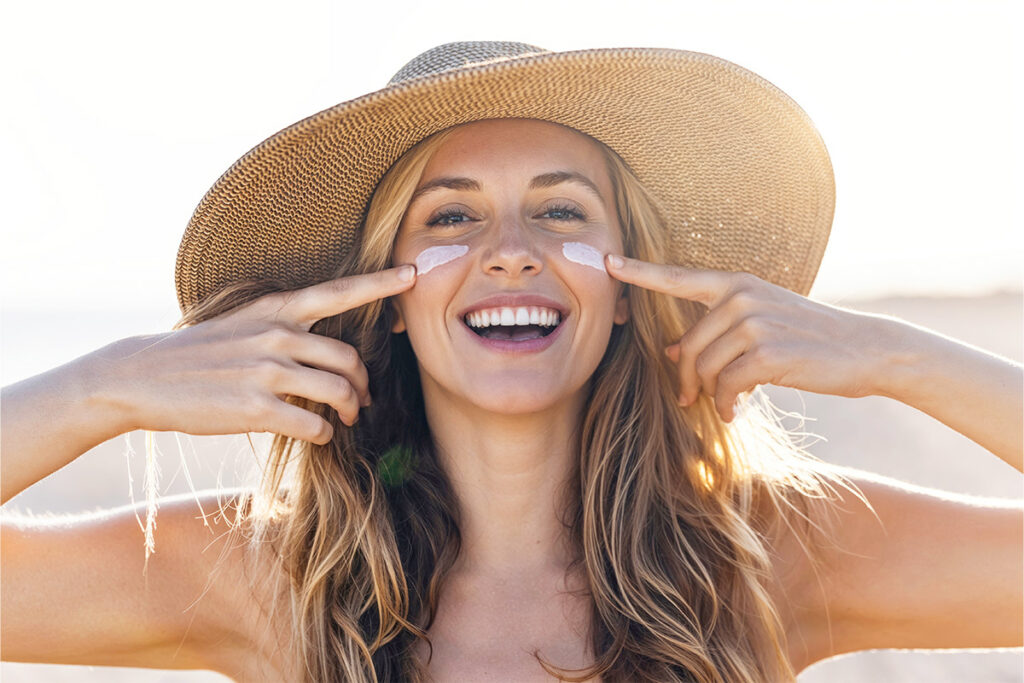I think most people would agree that a bright, sunny day can really improve your mood. Soaking up the sun has numerous health benefits, such as improving your mental well-being and playing a role in the synthesis of Vitamin D.
Solar radiation can also have negative effects, especially on our skin. Up to 80% of the visible signs of aging are caused by sun exposure. This type of aging is called photoaging characterized by fine lines, wrinkles, skin laxity, and dark spots. Sun exposure is also the leading cause of skin cancer. However, there is a way to enjoy your time in the sun while also protecting your skin. The key is understanding the different types of solar and ultraviolet (UV) rays and how they impact skin health.
Ultraviolet (UV) Rays
You’ve probably heard of UV rays before and may even be familiar with the two types, ultraviolet A (UVA) rays and ultraviolet B (UVB) rays. While these rays only account for 5% of the sun’s radiation that reaches the earth’s surface, their impact can have a profound effect on skin health. UV rays generate free radicals that over time damage collagen and elastin leading to wrinkles and skin laxity.
UVA Rays
UVA rays are long-wave ultraviolet rays that penetrate deep into the skin resulting in premature skin aging and skin cancer. They can reach the dermal level causing damage to collagen and elastin. These rays are the most prevalent comprising 95% of sun’s UV rays reaching the earth’s surface. UVA rays are strong and consistent with the ability to penetrate through glass and clouds.
UVB Rays
UVB rays are short-wave ultraviolet rays that penetrate the skin surface (epidermis) resulting in a sun tan or sunburn depending on the amount of exposure. UVB rays comprise 5% of the sun’s UV rays reaching the earth and their strength is dependent on time of day, season, and location. UVB rays are not able to penetrate through glass.
Even though UVB rays do not penetrate as deeply as UVA, they can also contribute to long term skin damage and skin cancers. Repeated sunburns can reduce your body’s natural regenerative capacity, thus increasing your risk of skin cancer.
Solar Blue Light
Visible light accounts for about 50% of solar radiation. Within the visible light spectrum, blue light is a particularly high-energy visible light that contributes to skin aging. Blue light causes skin hyperpigmentation or dark spots, especially for those with darker skin tones.
Artificial blue light emitted by your laptop, cell phone, television or LED lighting has been implicated in contributing to skin aging. The intensity of blue light emitted by these devices is significantly less than that of the sun. Without sunlight exposure, it would take a very long time to get effective damage for skin pigmentation changes by normal daily exposure to artificial lighting and electronic devices.
Protecting Your Skin from the Sun
The body has a built-in protection mechanism from the sun thanks to specialized pigment skin cells called melanocytes. These cells produce pigments of red, yellow, brown, and black in different combinations and distribute them to neighboring skin cells resulting in your natural skin color and tone. When the skin is exposed to sunlight, this production is increased in an effort to reduce the amount of sunlight that can damage skin. What’s interesting is that this pigment sits like an umbrella over the DNA protecting it from the sun’s damaging rays. Think of tinting the windows of your car – the darker the tint, the more sunlight you block.
In general, the darker your skin tone, the more natural sun protection you inherently possess. However, no matter how dark your skin tone, your skin still absorbs sunlight, and melanocytes get called into action to increase pigment production in an effort to protect your skin. Over time, the cumulative effect of UV and blue light damage these pigment producing cells leading to sun spots or uneven skin tone. This is why additional efforts are needed to protect your skin from the damaging rays of the sun to help prevent photoaging and reduce the risk of skin cancer.
Shade and Sun Protective Clothing
When you are outdoors for extended periods of time, take advantage of natural or artificial shade to reduce the intensity of direct sun exposure – large shade trees, an umbrella, gazebo, or building overhang. Sun protective clothing, hats, and sunglasses also limit your skin’s sun exposure.
Sunscreen
Sunscreen provides a protective layer on skin to filter UV absorption. Commonly exposed areas such as the face, neck, chest, and back of hands are subject to the cumulative effect of UV from not just outdoor sun exposure but also through windows in your car, home and office. This is why year-round, daily use of sunscreen is important to help mitigate photoaging.
Sunscreen Tips
- SPF rating on a sunscreen only refers to the sun protection factor against UVB. Look for a high rating (SPF 30 or above) to get the maximum protection.
- Sunscreens labeled Broad Spectrum indicate they meet the FDA standards for UVA protection.
- Zinc oxide in sunscreen offers protection against both UVA and UVB rays and performs well in the longer UVA wavelength range.
- Titanium dioxide in sunscreen also offers protection against both UVA and UVB rays, performing best against UVB rays. It also can provide protection against visible light.
- Iron oxides, typically used in tinted sunscreens for color, enhance defense against blue light.
- A nickel-sized amount (1/2 teaspoon) of sunscreen is recommended to cover the face and neck for effective sun protection.
- Reapply sunscreen every 2 hours, or more frequently if swimming, sweating or toweling off.
Being aware of how the different types of solar and UV rays impact skin can help you make smart choices when it comes to sun protection.
For daily sun protection, Biopelle Tinted Facial Sunscreen is a broad spectrum, SPF 30 sunscreen featuring key active ingredients, Zinc Oxide and Titanium Dioxide, Iron Oxides, and soothing ingredients like Aloe Vera, Green Tea Extract and Panthenol to physically block UVA, UVB & Blue Light, soothe the skin and give your skin a nice bronze tinted glow.

